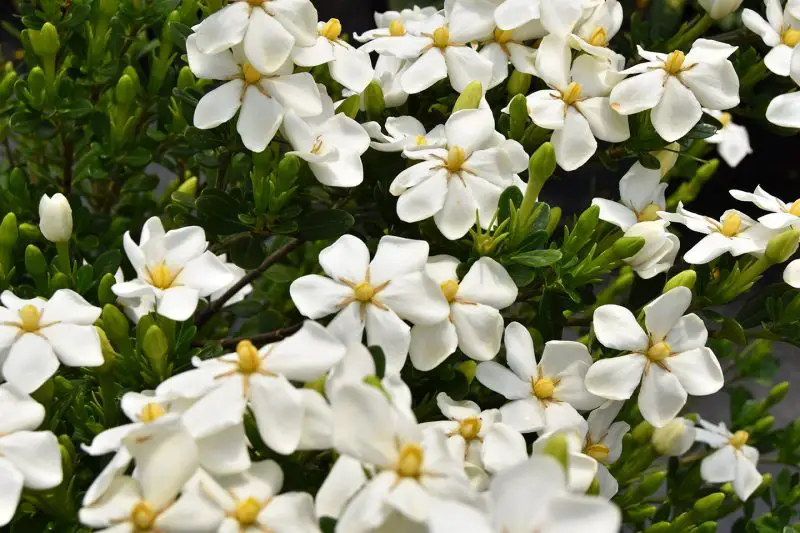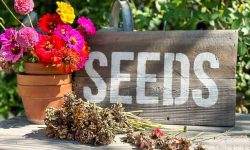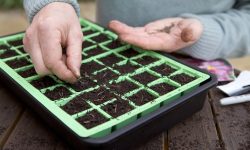Star jasmine is a stunning climbing plant loved for its glossy green leaves and clusters of fragrant white flowers. With the right care, it quickly transforms fences, pergolas, and walls into lush green backdrops filled with seasonal beauty. Many gardeners choose star jasmine not only for its visual charm but also for its ability to create a refreshing, natural atmosphere.
One of the most common questions among plant lovers is: how fast does star jasmine grow? Understanding its growth rate helps you plan your garden design and ensure thriving coverage year after year. With proper sunlight, soil, and pruning, this resilient climber can reward you with vigorous growth and endless blooms.
Understanding About Gardenia

Gardenia, with its glossy evergreen leaves and intoxicating fragrance, is one of the most beloved ornamental shrubs worldwide. Native to tropical and subtropical regions, this plant belongs to the Rubiaceae family and thrives in warm, humid environments. Its creamy-white flowers are often used in perfumes, bridal bouquets, and traditional gardens, making it a symbol of elegance and purity. Beyond beauty, Gardenias also carry cultural meanings, representing trust, clarity, and secret love in different traditions.
This plant is not only valued for aesthetics but also for its unique growing requirements. Gardenias prefer acidic, well-draining soil and need consistent moisture to flourish. They thrive in bright, indirect sunlight but can struggle under harsh afternoon rays. Understanding their sensitivity to changes in light, temperature, and humidity is crucial for successful cultivation. Gardenias are also prone to issues like yellowing leaves or bud drop if their conditions are not met, which is why careful attention is essential.
In addition to ornamental uses, Gardenias have been traditionally used in herbal medicine in some Asian cultures. Extracts from the flowers and fruits were applied for calming, detoxifying, and anti-inflammatory purposes. Modern research also explores the potential of Gardenia extracts in skincare and wellness. Whether grown indoors as a potted plant or outdoors in a garden landscape, Gardenias offer unmatched charm when cared for properly. By learning the fundamentals of this plant, gardeners can enjoy healthy growth and long-lasting blooms that fill spaces with fragrance and beauty.
Choosing the Right Location
Sunlight Requirements
Gardenias thrive in bright, indirect sunlight. Too much direct sun can scorch leaves and reduce flowering. Morning sunlight with afternoon shade is ideal, ensuring healthy growth without stress.
Light levels directly impact photosynthesis and flower production. Insufficient light may cause poor growth and fewer blooms. Planting in filtered sunlight protects leaves while providing energy for vibrant flowers. A consistent light source promotes strong stems and healthy foliage.
Temperature also interacts with light. Gardenias prefer warm conditions but may suffer in extreme heat. Choosing the right location balances light, temperature, and protection from harsh environmental factors. A carefully selected site ensures vigorous growth and abundant, fragrant flowers year after year.
Soil Selection and Preparation
Gardenias require well-draining, acidic soil with a pH of 5.0 to 6.5. Poorly drained soil can lead to root rot and weak growth. Incorporate organic matter such as compost or peat moss to improve fertility and texture.
Preparing the soil involves loosening it to a depth of at least twelve inches. This allows roots to expand easily and access nutrients. Lightly moisten soil before planting to reduce stress on the roots and encourage early establishment.
Regular testing of soil pH ensures the environment remains suitable for gardenias. Amending with sulfur or acid-based fertilizers maintains the correct acidity. Healthy soil supports strong roots, vibrant foliage, and consistent flowering. Proper preparation guarantees that gardenias flourish in their new location.
Selecting Healthy Plants
Choose gardenias with vibrant green leaves and firm stems. Avoid plants with yellowing leaves, damaged branches, or signs of pests and disease. Healthy plants adapt quickly to new environments and flower reliably.
Inspect roots before purchase. Well-formed, white roots indicate a strong foundation for future growth. Container-grown plants should not be root-bound, as restricted roots limit nutrient uptake and bloom potential.
Selecting the right plant sets the stage for long-term success. A healthy gardenia establishes quickly, grows vigorously, and produces abundant flowers. Starting with quality plants reduces maintenance and ensures a more resilient, fragrant garden.
Planting Gardenias
Timing and Best Season
Choosing the right time to plant gardenias plays a key role in their long-term success. Early spring or early summer offers favorable conditions with warmer soil and steady temperatures, giving young plants the best chance to develop strong roots. If planted too early, late frosts can damage tender shoots, while late planting in midsummer may expose gardenias to harsh heat and dry soil, causing stress. Proper timing ensures that the plant invests its energy into root growth instead of fighting environmental challenges.
Gardenias also respond to seasonal moisture and daylight cycles. Planting during a period of stable rainfall helps the soil remain evenly moist without excess watering. On the other hand, hot, dry conditions can hinder root establishment and lead to poor flowering in the first year. By planting before peak summer heat, gardeners give gardenias ample time to settle and prepare for their blooming season. Well-timed planting builds a strong foundation, ensuring healthier plants and more vibrant flowers for years to come.
Planting Technique
A precise planting technique directly impacts the health and vigor of gardenias. Begin by digging a hole that is wide enough for roots to spread freely and deep enough to match the original root ball level. Planting too deep can suffocate roots, while planting too shallow may expose them to drying. After placing the gardenia in the hole, spreading the roots carefully encourages outward growth and stronger establishment. Properly prepared soil beneath the plant reduces stress and supports nutrient absorption.
Once the plant is positioned, refill the hole with nutrient-rich soil and press lightly to remove air pockets. Watering immediately after planting settles the soil and initiates root contact with moisture. Applying a two- to three-inch layer of mulch conserves water, stabilizes soil temperature, and prevents weed competition. This careful planting process minimizes transplant shock, enabling gardenias to adjust quickly to their new environment. When done correctly, these steps encourage lush foliage and consistent flowering over many growing seasons.
Spacing and Grouping
Gardenias require adequate space to thrive and maintain strong health. Crowded plants limit airflow, which can increase humidity around leaves and stems, creating a favorable environment for fungal diseases. Planting gardenias at least three to four feet apart allows sufficient room for each plant to expand naturally. Proper spacing ensures that sunlight reaches all parts of the plant, promoting even growth and maximizing the number of blooms. It also facilitates easier access for pruning, watering, and maintenance, reducing stress on the plant and improving long-term performance.
Strategically grouping gardenias can enhance both aesthetics and plant health. Clusters of gardenias create a striking visual effect and encourage cross-pollination, which may improve flower production. When designing groupings, pair gardenias with companion plants that share similar light, water, and soil requirements, such as azaleas or camellias. This harmony reduces maintenance challenges and enhances the overall beauty of the garden. Thoughtful spacing and grouping allow each gardenia to grow vigorously, develop strong stems, and produce abundant, fragrant flowers while creating a visually balanced and thriving landscape.
Watering and Fertilization
Watering Techniques for Healthy Gardenias
Gardenias need consistently moist soil, but they dislike being waterlogged. The key is to provide deep watering that soaks the root zone while allowing the top layer of soil to dry slightly between sessions. Overwatering can lead to root rot, while underwatering causes buds to drop before they bloom. The best practice is to check the soil regularly and water when the top inch feels dry to the touch. During the hot summer months, more frequent watering may be required to maintain soil moisture.
Using mulch around the base of your gardenia helps retain soil moisture and reduces the risk of sudden drying. Organic mulch such as pine bark or straw also improves soil structure over time. Gardenias thrive in slightly acidic soil, and mulching supports this condition. Morning watering is best because it allows excess moisture to evaporate throughout the day, reducing fungal problems. With balanced watering, your gardenia will produce lush foliage and abundant blossoms.
Fertilization Strategies for Strong Growth
Fertilization plays a major role in keeping gardenias healthy and blooming. These plants are heavy feeders and require nutrients to maintain vibrant green leaves and fragrant flowers. The best approach is to use a fertilizer specially formulated for acid-loving plants, which usually contains higher levels of nitrogen, iron, and magnesium. Applying fertilizer every 4 to 6 weeks during the growing season provides steady nutrition for vigorous growth.
When applying fertilizer, it is important not to overfeed, as too much nitrogen can cause leafy growth at the expense of flowers. Always water the soil after feeding to help nutrients penetrate the roots and avoid burning. Slow-release fertilizers can also be an excellent option for long-term nourishment. In cooler months, reduce feeding to prevent stress during dormancy. With proper fertilization, gardenias develop strong roots, healthy leaves, and abundant flowers that last longer.
Pruning and Maintenance
Regular Pruning Practices
Regular pruning is one of the most effective ways to keep gardenias healthy, attractive, and long-lasting. By cutting away weak, damaged, or tangled stems, you allow air and light to circulate more freely through the plant. Improved circulation reduces the chance of fungal infections such as powdery mildew, while better light penetration stimulates even growth across all branches. The ideal time to prune is right after the blooming season, as this gives the plant enough time to recover and prepare for new shoots before the next cycle of buds and flowers. Pruning too early or too late can disrupt blooming and stress the plant unnecessarily.
To ensure successful pruning, always use sharp, disinfected tools. Dull blades may crush stems, creating wounds that attract pests and diseases. Focus first on removing deadwood and thinning out crowded areas where branches rub together. Once the plant is cleaned up, you can carefully shape it for symmetry and aesthetic appeal. This process also redirects nutrients toward strong, healthy stems, which boosts flower production. When done consistently year after year, pruning becomes an essential practice that maintains both beauty and vitality in your gardenia plants.
Long-Term Maintenance Strategies
Maintaining gardenias involves more than trimming branches—it requires a complete care plan designed to support growth over the years. Start by monitoring soil quality regularly, as gardenias thrive in slightly acidic, well-draining conditions. If the soil becomes compacted, loosen it to encourage airflow and root development. Keeping the base area clean by removing fallen leaves or plant debris is another critical task, as this prevents pests and fungal spores from establishing around the roots. These small but consistent efforts form the foundation of long-term health.
Nutrient management also plays a major role in sustaining vitality. Use fertilizers formulated for acid-loving plants, applying them at intervals that match the plant’s growth cycles. Gardenias that produce heavy blooms may also need support in the form of stakes or trellises to prevent stems from breaking under the weight of flowers. Watching growth patterns closely allows you to detect early signs of stress, such as leaf yellowing or stunted shoots, and make corrections quickly. When combined, these strategies ensure that your gardenia remains vigorous, disease-free, and capable of producing lush foliage and fragrant flowers year after year.
Pest and Disease Management
Preventing Common Pests
Keeping pests away from gardenias starts with preventive care and consistent observation. Healthy plants are far less likely to attract large infestations, so providing optimal conditions is the first step. Gardenias are particularly susceptible to aphids, spider mites, scale insects, and caterpillars, which feed on leaves and stems, weakening growth and reducing flower production. Inspecting the undersides of leaves and young shoots weekly allows you to catch early signs of trouble. If pests are detected, a strong spray of water can dislodge them without harming the plant. Organic insecticidal soaps and horticultural oils are also gentle yet effective solutions.
In addition to manual and organic controls, gardeners can take advantage of biological pest management. Ladybugs, lacewings, and predatory mites naturally reduce harmful insect populations without disturbing the ecosystem. Encouraging these beneficial insects helps maintain a balanced garden environment. Limiting chemical pesticide use is also crucial, as it prevents damage to pollinators such as bees, which gardenias rely on for reproduction. A proactive, environmentally friendly strategy ensures pests remain under control while preserving the natural beauty of the garden.
Controlling Diseases Effectively
Diseases such as powdery mildew, leaf spot, and root rot are common problems for gardenias, especially when conditions are humid or soil remains overly wet. Preventive measures are the most effective approach. Ensure the plant has good airflow by pruning excess branches and avoiding overcrowding. Watering at the base rather than overhead reduces leaf wetness, lowering the risk of fungal infections. Mulching also helps regulate soil moisture while keeping leaves dry. Early action, such as removing affected foliage, prevents disease from spreading to healthy parts of the plant.
When infections persist despite preventive care, treatment becomes necessary. Organic fungicides, including neem oil and baking soda solutions, can control minor outbreaks without harming beneficial organisms. For more severe problems, stronger fungicidal sprays may be used, but always according to recommended guidelines. Soil-borne diseases like root rot can be minimized by improving drainage or using raised beds. Consistent monitoring is vital, as diseases spread quickly if ignored. Through timely care and balanced management, gardenias can resist harmful pathogens and continue producing healthy, fragrant flowers season after season.
Seasonal Care
Spring Care
Spring is the season of active growth, making it the best time to rejuvenate the plant after winter dormancy. Start by clearing away any debris, mulch, or fallen leaves around the base to allow fresh air circulation. Apply a balanced, slow-release fertilizer to provide essential nutrients for new shoots and flower buds. Water regularly but avoid overwatering, as soggy soil can stress the roots. Pruning lightly in spring also helps shape the plant and encourages stronger branching.
As temperatures rise, check the soil condition and ensure it stays consistently moist but well-drained. Adding a thin layer of compost or organic mulch helps retain moisture and improves soil fertility. Watch for early signs of pests such as aphids, which often appear in spring, and treat them promptly with natural or chemical solutions. With proper spring care, the plant establishes a healthy foundation for lush summer growth and abundant blooms.
Summer Care
Summer brings intense growth and flowering, so consistent attention is essential. During this season, water deeply and regularly, especially in hot or dry climates. Mulching is vital to keep the soil cool and reduce evaporation. Feeding with a phosphorus-rich fertilizer can enhance flower production and maintain vibrant colors. Deadheading spent blooms not only keeps the plant neat but also stimulates continuous flowering throughout the summer months.
Shade protection may be necessary in extremely hot regions to prevent leaf scorch. Inspect leaves and stems for signs of pests such as spider mites or fungal diseases that thrive in warm, humid conditions. Treat problems promptly before they spread. Summer is also a good time to provide structural support, such as stakes or trellises, if the plant grows vigorously. With proper summer care, the plant maintains peak vitality and displays long-lasting, showy blooms.
Autumn Care
Autumn is a transitional season when growth begins to slow, but the plant still needs attentive care to prepare for winter. Gradually reduce watering as temperatures cool, but do not let the soil dry out completely. Apply a final dose of balanced fertilizer early in autumn to strengthen the roots before dormancy. Remove any weak or diseased stems to reduce the risk of winter damage. Light pruning helps maintain shape without encouraging excessive new growth.
This is also the season to refresh mulch, creating a protective layer around the root zone. Mulching keeps soil temperatures stable and prevents weed competition. Watch for signs of fungal issues caused by cooler, damp conditions, and treat them before winter sets in. Autumn is also an excellent time to plant new specimens, as the soil remains warm enough for roots to establish. Proper autumn care ensures the plant enters winter strong and well-prepared.
Winter Care
Winter care focuses on protection and ensuring survival during cold or harsh weather. In regions with mild winters, most plants remain dormant but require minimal watering to prevent the roots from drying out. In colder climates, apply a thick mulch layer or cover the base with straw or burlap to shield roots from frost damage. Container-grown plants should be moved to sheltered areas, such as a greenhouse or indoors, to avoid freezing.
Avoid heavy pruning during winter, as it can weaken the plant and expose it to frost injury. Instead, simply remove any broken or dead branches. Check regularly for signs of rodent damage, as pests sometimes feed on bark or roots in winter. If grown indoors, provide adequate light and avoid overwatering. By giving careful attention during winter, the plant remains protected and will be ready to burst into healthy growth once spring arrives.
Enhancing Flowering
Optimizing Growing Conditions
Creating the ideal environment is the most effective way to encourage abundant and long-lasting blooms. Gardenias thrive in locations with at least four to six hours of bright, indirect sunlight each day. Too much shade reduces flower production, while excessive direct sunlight can scorch the leaves. Soil also plays a central role; it must be slightly acidic, well-draining, and rich in organic matter. When soil conditions are optimal, the plant channels its energy into producing vibrant and fragrant flowers instead of just maintaining foliage.
Watering practices are equally important for optimizing growth and flowering. Gardenias prefer consistent moisture but will not tolerate soggy roots. Overwatering may lead to root rot, which weakens the plant and diminishes flowering. Feeding with a fertilizer rich in phosphorus strengthens bud formation and enhances bloom size and color. In contrast, nitrogen-heavy fertilizers should be avoided, as they encourage leafy growth at the expense of flowers. By balancing sunlight, water, and nutrition carefully, gardeners can ensure their gardenias reward them with a profusion of blooms year after year.
Using Pruning and Training Techniques
Pruning is more than just shaping; it is a vital practice that directly influences flowering success. Deadheading, or removing spent blooms, signals to the plant that it should redirect energy into producing new buds rather than seeds. This simple technique extends the blooming season, allowing the plant to remain colorful and fragrant for a longer period. Seasonal pruning after major bloom cycles also thins overcrowded branches, improves airflow, and ensures that sunlight penetrates deep into the canopy, which stimulates the growth of new flowering stems.
Training techniques complement pruning by guiding plant growth in ways that maximize exposure to light. Long stems can be gently secured to trellises, arbors, or other supports, allowing blooms to be displayed more evenly across the plant. This not only enhances aesthetic appeal but also ensures that more buds develop along the length of the stem. For compact varieties, shaping the plant into a rounded form encourages even bud distribution. By combining pruning with structured training, gardeners can greatly enhance the ornamental value of their gardenias and enjoy prolonged, vibrant displays of blossoms.
FAQ About How to Plant Gardenia
What is the best time of year to plant star jasmine?
The best time to plant star jasmine is in spring or early fall when temperatures are mild. This allows the roots to establish before extreme summer heat or winter cold. Planting during these seasons helps the vine settle quickly and ensures faster growth and healthier development.
How often should star jasmine be watered?
Water star jasmine regularly during its first year to establish strong roots, usually once or twice a week. Once mature, it becomes drought tolerant and only needs watering during prolonged dry spells. Deep watering is recommended to encourage deeper root systems and long-term plant resilience.
Does star jasmine need full sun or partial shade?
Star jasmine thrives in full sun but can tolerate partial shade. For maximum flowering, aim for at least six hours of direct sunlight daily. In very hot regions, providing light afternoon shade helps protect the plant from scorching while still allowing abundant blooms and lush foliage.
How fast does star jasmine grow each year?
Star jasmine grows about 3 to 6 feet per year under ideal conditions. Growth speed depends on factors like soil quality, sunlight, watering, and pruning. With proper care, it quickly covers trellises, fences, or walls, making it a popular choice for fast, lush green screens.
Can star jasmine survive winter in colder climates?
Star jasmine is hardy in USDA zones 8–11. In colder regions, it may suffer frost damage if temperatures drop below 10°F (-12°C). Protecting roots with mulch or growing it in containers that can be moved indoors helps preserve the plant through harsh winters and extend its lifespan.
Conclusion
Caring for your plant throughout the seasons is the key to keeping it healthy and blooming year after year. Each stage of the growing cycle requires attention, from spring growth and summer flowering to autumn preparation and winter protection. By understanding seasonal care needs, you give your plant the best chance to thrive. Combine consistent watering, proper pruning, and thoughtful protection with patience, and you will enjoy lush foliage and stunning flowers. With the right approach, your garden can remain vibrant across the seasons, bringing beauty and joy to your outdoor space.






